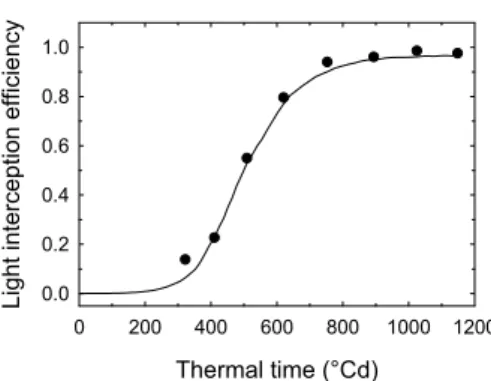HAL Id: hal-02751779
https://hal.inrae.fr/hal-02751779
Submitted on 3 Jun 2020HAL is a multi-disciplinary open access archive for the deposit and dissemination of sci-entific research documents, whether they are pub-lished or not. The documents may come from teaching and research institutions in France or abroad, or from public or private research centers.
L’archive ouverte pluridisciplinaire HAL, est destinée au dépôt et à la diffusion de documents scientifiques de niveau recherche, publiés ou non, émanant des établissements d’enseignement et de recherche français ou étrangers, des laboratoires publics ou privés.
Estimation of the amount of light intercepted by a plant
in natural and artificial environments: Contribution of
3D virtual plants in sunflower and Arabidopsis thaliana
Karine Chenu, Hervé Rey, Jean Dauzat, Jérémie Lecoeur
To cite this version:
Karine Chenu, Hervé Rey, Jean Dauzat, Jérémie Lecoeur. Estimation of the amount of light inter-cepted by a plant in natural and artificial environments: Contribution of 3D virtual plants in sunflower and Arabidopsis thaliana. 5. International Workshop on Functional Structural Plant Models, Nov 2007, Napier, New Zealand. �hal-02751779�
Estimation of the amount of light intercepted by a plant
in natural and artificial environments:
Contribution of 3D virtual plants in sunflower and Arabidopsis thaliana
Karine Chenu
1, Hervé Rey
2, Jean Dauzat
2and Jérémie Lecoeur
31
INRA, UMR 759 LEPSE, 2 place Viala, 34060 Montpellier, France
2
CIRAD, UMR AMAP, Bd de la Lironde, 34398 Montpellier, France
3SupAgro, UMR 759
LEPSE, 2 place Viala, 34060 Montpellier, France
chenu@supagro.inra.fr
-
lecoeur@supagro.inra.fr
Keywords: light interception, 3D virtual plant, radiative balance model, sunflower,
Arabidospsis.
Light interception is a major contributor to biomass accumulation of crops. Beer's law has been extensively used to estimate the amount of light intercepted by a plant at canopy level. This method, based on the use of the leaf area index (LAI), is designed for well-developed crops where the canopy is assumed to be a turbid medium (Jones, 1992). However this assumption is seldom verified and in most situations canopies are strongly heterogeneous, as for example in perennial crops such as vineyards and orchards (e.g. Louarn et al., 2007) or in row crops during the first developmental stages or when leaf senescence occurs. We propose here to test a method based on 3D modelling to quantify the local light environment of plants in different situations, including artificial conditions.
A
B
C
Fig. 1. (A) Change in virtual sunflower plants over time (100°Cd time step). (B) Representation of a virtual canopy of sunflower at flowering. (C) Map of intercepted light in a virtual canopy of sunflower (top view of the canopy).
Thermal time (°Cd) 0 200 400 600 800 1000 1200 Light interception efficiency 0.0 0.2 0.4 0.6 0.8 1.0
Fig. 2. Change with thermal time of observed (dots) and simulated (line) light interception efficiency for a sunflower canopy in a field experiment.
3D virtual plants built from architectural measurements (Barczi JF et al., 1997) were used with a radiative balance model (Dauzat and Eroy, 1997) to characterise plant-environment interactions. A multi-directional approach was chosen to take into account direct and diffuse photosynthetically active radiations (PAR) which have a major influence on the plant radiative balance. Under natural conditions, when there was no obstacle to light, the direct-diffuse PAR ratio was derived from a single measurement of solar radiation above the canopy. In artificial conditions such as growth chambers or greenhouses, because of the presence of various occulting and reflecting materials and artificial light supplies, this ratio is more difficult to estimate. PAR sensors were specifically designed to measure the directional radiations received by plants in such environments. The effective radiation climate was mimicked by different virtual light sources whose characteristics were estimated from the directional measurements.
The method was tested in sunflower and in the rosette of Arabidopsis thaliana, in canopy or isolated plants, from plant germination to the end of the vegetative period (Fig. 1). Experiments were carried out in natural (field), semi-controlled (greenhouse) and totally artificial (growth chamber) light environments. Various light levels were imposed and different genotypes were used to test the model relevance to environmental and genetic variations in the plant architecture.
This approach was evaluated using measurements on light interception efficiency (Fig. 2) and it was compared to classical approaches (Beer's law for sunflower; leaf area x incident PAR for Arabidopsis) in the different situations. The model was particularly relevant to quantify light interception for crops in early growth stages, isolated plants or artificial environments. It was also able to characterise the local environment of different genotypes and to quantify the impact of architectural modifications on light interception. This 3D virtual plant approach is proposed as a tool to analyse the genotype-environment interactions and identify new selection criteria to improve light interception which is directly related to biomass production and yield.
References
Barczi, J.F., de Reffye, P., Caraglio, Y. 1997. Essai sur l'identification et la mise en oeuvre des paramètres nécessaires à la simulation d'une architecture végétale. In. Modélisation et simulation de l'architecture des végétaux. Science Update. INRA éditions, Paris, France, pp. 205-254.
Dauzat, J., Rapidel, B., Berger, A. 2001. Simulation of leaf transpiration and sap flow in virtual plants: model description and application to a coffee plantation in Costa Rica. Agricultural and forest meteorology 109: 143-160.
Jones, H.G. 1992. Plants and microclimate. A quantitative approach to environmental plant physiology. Cambridge University pres, Cambride, UK.
Louarn, G., Guédon, Y., Lecoeur, J., and Lebon, E. 2007. Quantitative analysis of the phenotypic variability of shoot architecture in two grapevine cultivars (Vitis vinifera L.). Annals of Botany 99: 425-437.
